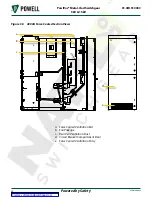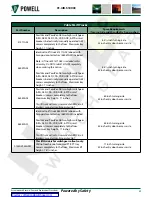
Powered by Safety
®
53
Maintenance
01.4IB.51000C
6) Control Contacts
The contacts should be inspected and
dressed or replaced when the surface
becomes seriously pitted. Unless repetitive
duty has been experienced, little attention
should be required.
7) Secondary Wiring
Check all wiring connections for tightness
including those at the current and potential
transformers and at the terminal blocks
where the circuits leave the switchgear.
Make sure that all secondary wiring
connections are properly connected to the
switchgear ground bus where indicated.
8) Mechanical Parts
Visually check and manually operate
the mechanical moving parts such as
the shutter, TOC, and MOC mechanism
operated cell switch assemblies, the key
interlock, hinged doors, and the rollout
features of the transformers and fuses.
Examine mechanical mating parts such as
the circuit breaker racking crank arms and
the switchgear guide rails.
9) Ventilation
Check all labyrinths, grillwork, and
air passages for obstructions and
accumulations of dirt. The air space under
the outdoor switchgear, which is necessary
for the entrance of ventilating air, should be
cleaned of leaves and other possible debris.
Replace or clean dirty filters.
10) Battery and Charging Equipment
The control battery is such an important
accessary to the switchgear operation
that it must be given special periodic
attention if it is to have a long life of reliable
service. Periodic inspections and test are
recommended in the battery supplier’s
instructions. During the same time that
the battery is routinely checked, inspect
the battery charger and remove any
accumulations of dust and dirt.
On all chargers, having a manual transfer
switch for setting the charging rate,
carefully check and ensure that the selector
switch is returned to the value appropriate
for a floating charge at the end of the
periodic inspection. Serious damage to the
control battery can occur if the charger is
left on a high charging rate for an extended
period of time.
11) Hardware
Check to see all anchor bolts and
switchgear hardware are tightened to
correct torque values. See
12) Heaters
If the switchgear is equipped with
anti-condensation heaters, check to see
that all heaters are energized and operating
properly. This may be done by using a
hook-on ammeter to measure the current
drawn by the heater.








































